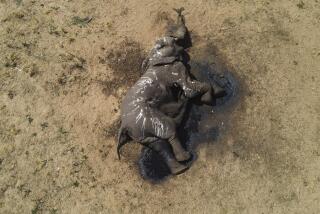120,000 endangered saiga antelopes die mysteriously in Kazakhstan

Saiga antelopes near Almaty, Kazakhstan, in this undated photo.
- Share via
More than 120,000 critically endangered saiga antelopes — more than one-third of the worldwide population — have died in Kazakhstan since mid-May, and the cause of the “catastrophic collapse” is unclear, officials said.
“Not a single animal survived in the affected herds,” the Convention on the Conservation of Migratory Species of Wild Animals, a United Nations-backed effort also known as CMS, said in a statement Thursday.
Pasteurella and Clostridia bacteria exacerbated the die-off, but they are not lethal unless the animal already has a weakened immune system, so experts are still trying to identify the underlying cause, CMS said.
Die-offs are not unusual among saigas, which largely live in Kazakhstan and are recognized for their bulbous, flexible noses that warm up freezing air and filter out dust, CMS said. A 2010 event killed 12,000, and a 1984 event killed about 100,000, it said, although the causes of those mass deaths “could not be conclusively identified.”
The die-offs often take place “in the birth period, when saiga females come together in vast herds to all give birth within a peak period of less than one week,” CMS said. This spring’s deaths affected four such herds, primarily killing mothers and calves, it said.
Saigas also have been hit hard by poaching, as the animal’s horns are used in traditional Chinese medicine. Poaching soared in the wake of the Soviet Union’s dissolution, and the saiga population plunged about 95% in the 1990s, leaving only about 50,000 of the animals alive worldwide, according to CMS. Kazakhstan has since banned hunting the antelope, and its numbers have started to grow again.
Officials are still counting the saigas that died in recent weeks, so it is likely that the final estimate will surpass 120,000, CMS said.
However, it said, the latest die-off appears to have ended, and there is hope for the endangered antelope’s numbers.
“Saiga antelopes often have twins and populations are able to rebound quickly,” CMS Executive Secretary Bradnee Chambers said in a statement. “Our hope is that if we can control what is driving these mass mortality events as well as tackle the No. 1 threat to saigas — wildlife crime and poaching — populations will be able to recover.”
“The loss of such a large proportion of the saiga population in such a short time is really sad,” Noah Greenwald, the Center for Biological Diversity’s endangered species director, told the Los Angeles Times on Sunday.
“Unfortunately mass die-offs of wildlife from previously unseen diseases is becoming all too familiar,” he said, adding that more than 7 million bats in North America have died of white-nose syndrome in the last decade.
“With international trade, microorganisms are passing through the world’s ports at an unprecedented rate,” Greenwald added. “Combined with diseases from livestock, one has to wonder if this is how the saiga got sick.”
For more news, follow @raablauren on Twitter.







